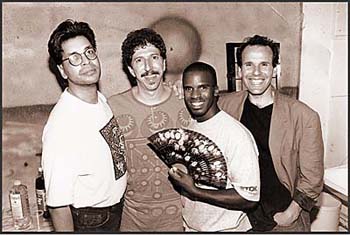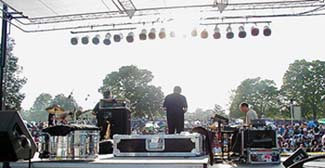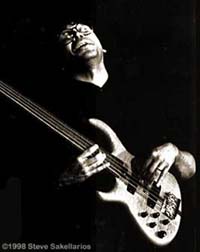|
I'm baffled by the persistent
prejudice against Yellowjackets. Too many people still
shrug them off. Too many, who should know better, still
assume that they belong between the more forgettable Spyro
Gyra stuff and the more embarrassing David Sanborn stuff
on radio stations programmed to "get you through the work
day." That they make toothless fuzak.
It just ain't so. I'm not
denying that the "contemporary jazz" scene, once a well-kept
nest, has become a rather shabby pigeonhole. But Yellowjackets
don't like it any more than we do. That's why, after a
career spanning more than two decades and multiple Grammy
nominations (and two wins), they've finally done away
with less-than-supportive major labels and taken full
creative control, financing and producing an album entirely
on their own. Mint Jam, recorded live over two
nights last July at the Mint in Los Angeles, should put
the prejudice to rest once and for all.
This double CD, sold exclusively
through Yellowjackets.com,
introduces eight previously unrecorded songs, and brings
new vitality to four old favorites. Having attended both
shows, I'm glad to say that the recording ably conserves
their energy; the music on Mint Jam is as fresh
and vigorous as it was when I first laid ears on it.
Yellowjackets have a practiced
knack for keeping their listeners listening, and Mint
Jam is no exception. One of the band's consistent
strengths is a mastery of exploratory modulation. They
blend idiomsóbetween songs and within themólike nobody's
business. Through careful changes of tonality and meter,
an A section feels one way, a B entirely another (not
to mention the C's and D's). Yet they mesh, synthesize
into a whole not only greater than the sum of its parts,
but also more fun.
At first, the solid, upbeat
shuffle of "Boomtown" connotes good, old-fashioned funk,
but before long a chromatic bridge has carried the tune
away, and it expands to accommodate a piano solo with
decidedly modal moments. Likewise, at its sunny start,
"Motet" doesn't quite let on that it will build to an
infectious gospel hook, but in retrospect it seems inevitable.
Citing "the spicy Cuban dish of the same name," Bob Mintzer
rightly fills "Mofongo" with sundry strong flavors. "Mosaic"
and "New Jig" both make good on the promise of their titles.
My personal favorite, Russell Ferrante's inventive homage
"Blues for KJ," opens with a cool, cerebral lyricism,
takes a few deep breaths to gather its steam, and pounces
into a spry, catchy lead line, full of blue-note sass
and syncopation.
 |
"KJ" is of course the great
Keith Jarrett, another musician without borders, equally
at home in Bach and Bird. Ferrante rounds out his salute
with a searching pedal-point soloóthe very technique by
which Jarrett has famously spun many standards into immortal
20-minute meditations. Another nod to one very significant
influence is the opening track, "Les is Mo," which I'm
guessing Ferrante had wanted to write and record for some
time. Anyone who knows Les McCann and Eddie Harris' Swiss
Movement (and everyone should) will thrill to this driving,
gospel-clockwork groove and its fond evocation of McCann's
rousing "You Got It In Your Soulness" piano solo.
 |
Other influences are less
apparent, but equally well-assimilated. Here the difference
between merely doing the homework and actually learning
something is clear: Mint Jam is as hearty as it
is heady. Even the most complex rhythmic experiments ("Tortoise
and the Hare, "New Jig") will stir you up. Even the longest,
most asymmetrically syncopated, bop-infused melodies ("Runferyerlife,"
"Statue of Liberty") will stick in your head. Even the
densest harmonic structures ("Mosaic," "Song for Carla")
will give you goosebumps. Or, to put it another way, this
just feels like a live album should.
Like several of the hallmark
recordings to which it rather bashfully aspires, Mint
Jam buzzes, as it were, with the verve of four musicians
at the top of their shared game: working hard and playing
hard, enjoying themselves and their audience, displaying
what they've already built and breaking new ground.
But in case you're still
not convinced, we should also talk about the playing.
I don't think saxophonist
Bob Mintzer ever met a phrase he couldn't turn. Whether
organized or improvised, Mintzer's melodies are so organic,
his accents so expressive, it's no wonder he's so comfortable
at the melodic helm of such a diverse musical catalog
(his most recent big band album, Homage to Count Basie,
just earned a Grammy nomination). And, after careful study
of "Mofongo" and "New Jig," I really can't think of anyone
else who so truly owns the EWI (Electric Wind Instrument).
Maybe it's because Mintzer allowed it the dignity of a
real instrument, when other MIDI-mad technophiles couldn't
get past the gimmick.
Russ Ferrante, too, has
an impressive vocabulary for a soloist, and he's not afraid
to take risks. But he hasn't forgotten the importance
of his rhythm section role. The real beauty of "Motet,"
for instance, is in his comping, his way of gradually
building it up under Mintzer's tenor solo, subtly modifying
voicings, adding energy, complexity. It takes genuine
musicianship and humility to understand how to give a
tune a place to go,an arc, and how to make someone else's
solo sound good. Ferrante folds a few synthy sounds into
the set (even having seen it, I must remind myself that
he's only one man), but in careful moderation; he spends
most of his time on the piano.
 |
Any rhythm section anywhere
would do well to have Jimmy Haslip on bass, not just because
he's so solid, but because he's an enormously generous
ensemble player, always listening to his bandmates, always
willing to share with them. Haslip's rich, gently-chorused
tone anchors the group and bolsters his own melodic and
soulful solos. Clearly he commands the instrument, but
I don't think he's out to dazzle the audience. He'd rather
move them, and so he does.
Still only in his mid-twenties and showing up other drummers
twice his age with half his chops, Marcus Baylor became
a Yellowjacket in April of 2000. But he behaves more like
a hummingbird, darting and flitting between the blossoms
of these works, bringing out their nectar. Whether he's
skipping gaily toward the solo section of "Motet," sending
sparks off the hi-hat in "Mofongo," or trading eights
with Haslip in "Evening News," (co-written by Baylor's
predecessor, longtime Yellowjackets drummer Will Kennedy,
it's a tall order), you wonder not only how he maneuvers
so well, but how he even stays airborne. Even among musicians
who clearly benefit from having played together for a
long time, Baylor fits right in; his addition is prolific.
It's another masterful modulation.
So no, this is not your
older brother's fusion band, a dying breed that won't
go gracefully. It's not another watered-down "smooth jazz"
act with no sense of history and no apparent future. This
is Yellowjackets, as good as it gets. The independent
spirit with which Mint Jam was made, and the unmistakable
vitality of its music, augurs well for its makers, for
your CD collection, and for jazz at large.
|